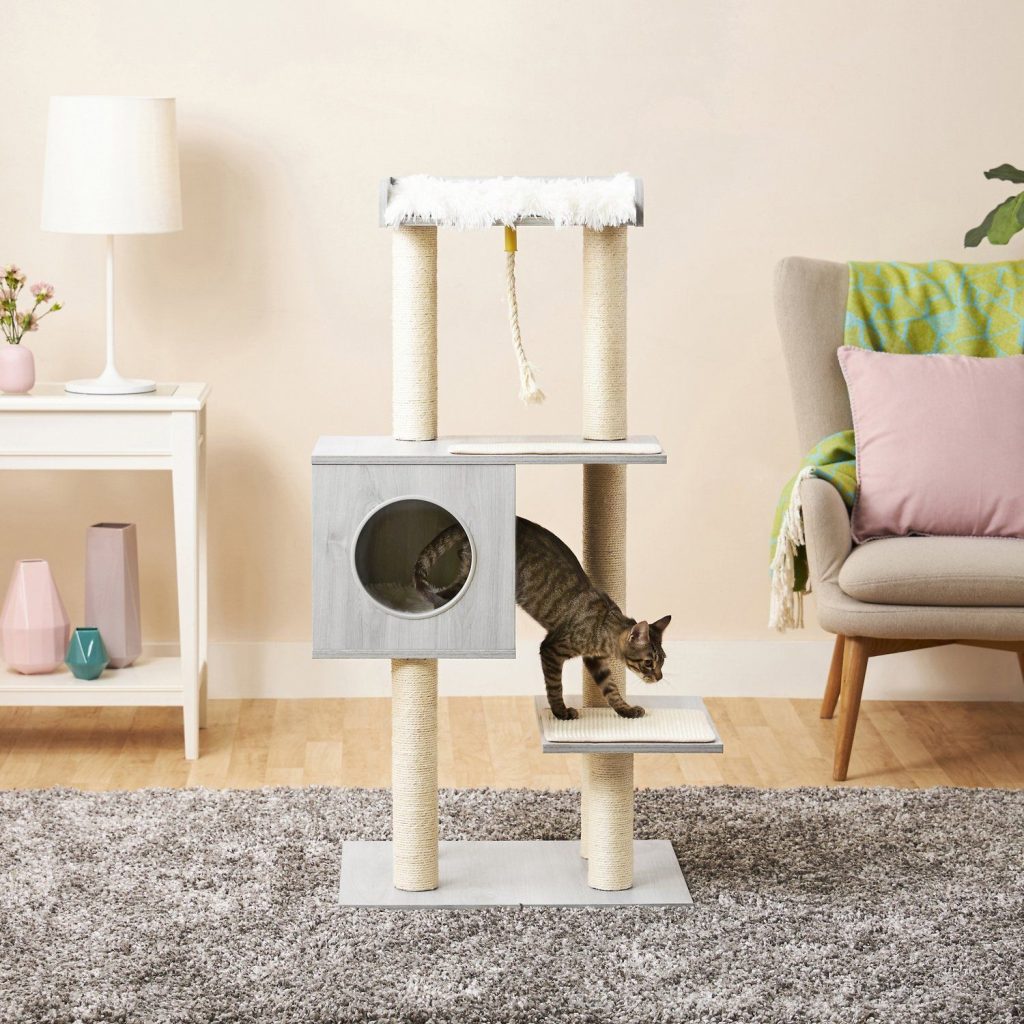If you’re a proud owner of a feline friend, then you know how important it is to keep them entertained and comfortable. That’s where cat trees come in! In this ultimate guide to cat trees, we’ll explore the wonderful world of these unique and versatile pet care products. From providing a safe haven for your cat to climb and explore, to offering a cozy spot for napping and scratching, cat trees have it all. Whether you’re a seasoned cat owner or are new to the world of feline companionship, this guide will provide you with all the information you need to choose the best cat tree for your furry friend. So get ready to enhance your cat’s playtime with our comprehensive guide!
Understanding Cat Trees
What is a cat tree?
A cat tree, also known as a cat tower or cat condo, is a piece of furniture designed specifically for cats. It typically consists of multiple levels, platforms, perches, and often includes scratching posts and toys. A cat tree provides an elevated and interactive space for cats to climb, play, scratch, and rest.
Why do cats need cat trees?
Cats are natural climbers and love to perch in high places. A cat tree offers vertical territory for cats, allowing them to observe their surroundings from a higher vantage point. It also serves as a safe space for them to exercise, stretch, and sharpen their claws. Cat trees provide mental stimulation, promote healthy behavior, and prevent boredom and destructive behavior in cats.
Different types of cat trees
Cat trees come in various shapes, sizes, and designs to suit different cats and living spaces. There are compact cat trees for small apartments, large cat trees for multiple cats, wall-mounted cat shelves for limited space, and outdoor cat trees for adventurous felines. Some cat trees even have additional features such as hammocks, tunnels, and scratching arches.
Factors to consider when choosing a cat tree
When selecting a cat tree, there are several factors to keep in mind. First, consider the size and weight of your cat to ensure the cat tree can accommodate them comfortably. Next, assess the available space in your home and choose a cat tree that fits well without overwhelming the room. It is also important to check the stability and construction of the cat tree, ensuring it is durable and safe for your cat. Finally, consider any additional features or accessories that may enhance your cat’s enjoyment, such as hanging toys or hideaway compartments.
Benefits of Cat Trees
Exercise and stimulation
Cat trees encourage cats to engage in physical activity, which is crucial for their overall health and well-being. The various levels, platforms, and perches provide opportunities for climbing, jumping, and exploring. This exercise helps to strengthen their muscles, maintain a healthy weight, and prevent obesity-related issues.
Scratching and stretching
Cats have an instinctual need to scratch and stretch to maintain the health of their claws and muscles. Cat trees often feature scratching posts or sisal rope, providing a designated area for cats to indulge in their scratching behavior. This helps protect your furniture from being damaged and gives your cat an appropriate outlet for their natural instincts.
Vertical territory
Cats are territorial animals, and having access to vertical spaces helps them establish their territory and feel secure. Cat trees offer multiple levels and perches where cats can claim their personal space and observe their surroundings. This vertical territory reduces stress, gives them a sense of security, and allows them to display their natural behaviors.
Promoting nail health
Regular scratching on a cat tree helps to keep your cat’s nails healthy and in good condition. When cats scratch, they remove the dead outer layer of their claws and stimulate the growth of new, sharper claws. By providing a suitable scratching surface on a cat tree, you can prevent your cat from scratching your furniture or carpets and ensure their nails stay in optimal condition.
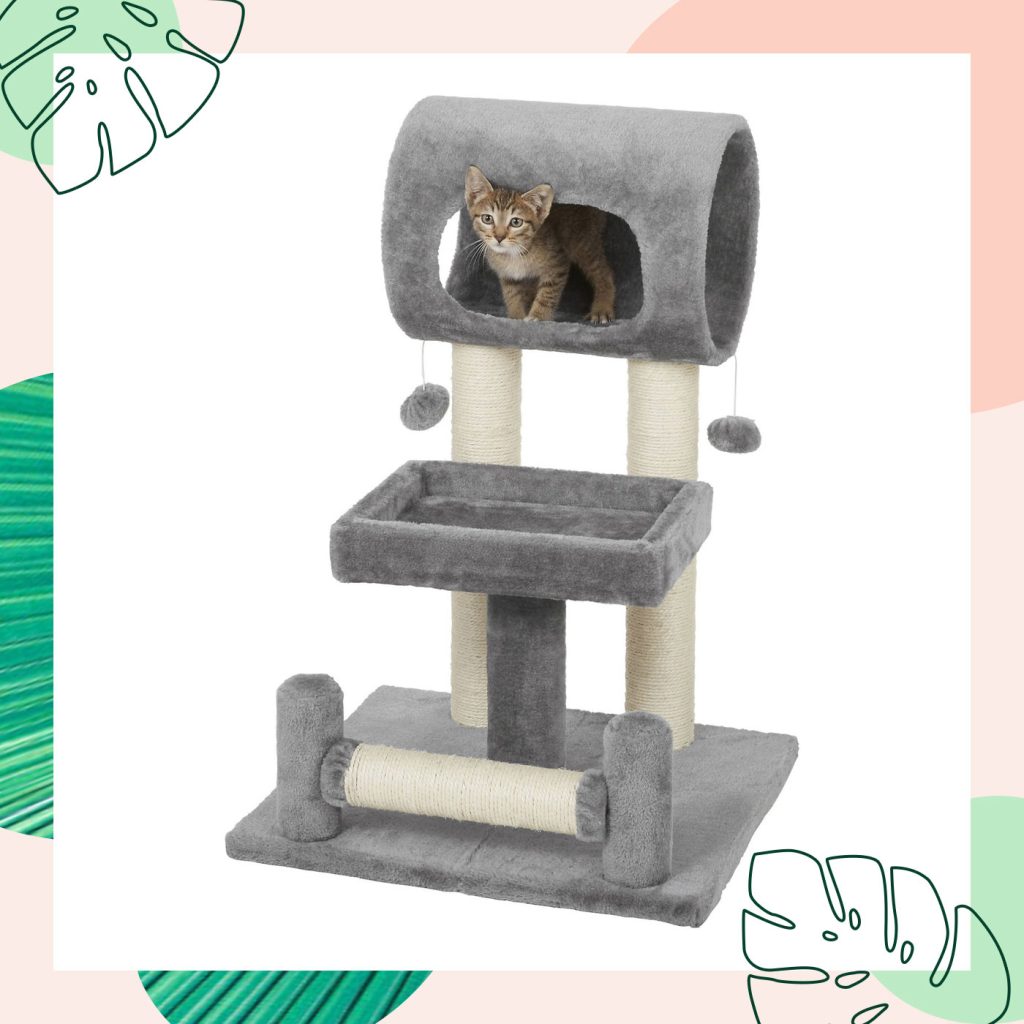
Features to Look for in a Cat Tree
Sturdy construction
One of the essential features to consider in a cat tree is its construction. Look for a cat tree made from sturdy materials such as solid wood or heavy-duty PVC. The base should be wide and stable to prevent tipping, and the overall structure should be reinforced to support your cat’s weight and movements. A well-built cat tree will provide a safe and secure environment for your cat.
Multiple platforms and perches
Cat trees with multiple levels, platforms, and perches offer more options for your cat to climb, rest, and play. Look for cat trees with varying heights and configurations, allowing your cat to choose their preferred spot to relax or observe their surroundings. The more options for perching and resting, the more your cat will appreciate their new cat tree.
Scratching posts
A cat tree should have dedicated scratching posts or surfaces to fulfill your cat’s natural scratching instinct. Look for cat trees with sturdy sisal rope or durable sisal fabric covering the posts. Cats prefer the texture of sisal and are more likely to use it for scratching, which will help protect your furniture from their claws.
Hanging toys
Many cat trees come with hanging toys or attachments to provide additional entertainment for your cat. These toys can include feathers, bells, or balls, which will stimulate their prey instinct and keep them engaged and entertained. Hanging toys can be easily replaced or switched out to keep your cat’s interest and prevent boredom.
Hideaway compartments
Some cat trees feature hideaway compartments or enclosed spaces where cats can retreat and have some privacy. These compartments can provide a cozy and secure spot for your cat to nap or relax away from any disturbances. These hideaway compartments are especially appealing to cats who prefer a bit of solitude.
Easy to clean materials
Cat trees can get dirty or collect fur over time, so it is essential to choose one that is easy to clean. Look for cat trees with removable and washable cushions or covers. Additionally, opt for materials that are resistant to stains and can be easily wiped clean. A cat tree that is easy to maintain will ensure a hygienic and pleasant environment for your cat.
Choosing the Right Size and Height
Considering your cat’s size and weight
When choosing a cat tree, take into account the size and weight of your cat. Larger cats will require more substantial and sturdy cat trees to support their weight, while smaller cats may be content with a more compact option. Assess your cat’s length and height to ensure the cat tree provides enough space for them to stretch out and move comfortably.
Determining the available space in your home
Measure the available space in your home where you intend to place the cat tree. Consider the height, width, and depth of the area to determine the maximum dimensions that the cat tree should not exceed. It is essential to leave enough room for your cat to navigate around the cat tree without feeling cramped or compromising the overall layout of your home.
Optimal height for climbing and jumping
Cats love to climb and jump, so it is important to choose a cat tree with an optimal height. A taller cat tree will allow your cat to climb and reach higher areas, fulfilling their natural instincts and providing more exercise opportunities. Look for cat trees with multiple levels and high perches to ensure your cat can enjoy vertical exploration.
Balancing stability and space efficiency
While you want a cat tree that provides ample space for your cat, it is also essential to consider the stability and space efficiency of the cat tree. A cat tree that is too top-heavy or bulky may be prone to tipping or take up too much floor space. Find a balance between a stable cat tree that can withstand your cat’s movements and a size that fits comfortably in your home.
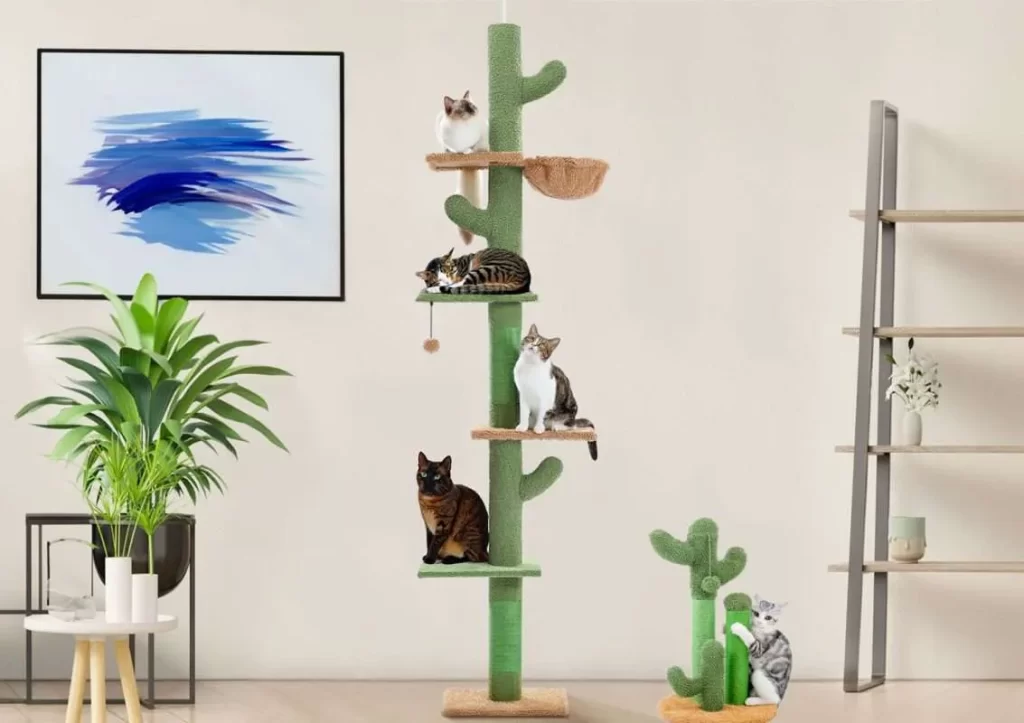
Assembly and Maintenance
Reading the instructions
Before assembling your cat tree, carefully read and follow the manufacturer’s instructions. Familiarize yourself with all the parts, hardware, and tools required for assembly. Taking the time to understand the instructions will make the assembly process smoother and ensure the cat tree is put together correctly.
Required tools
Most cat trees come with the necessary tools to complete the assembly, such as wrenches or Allen keys. However, it is always a good idea to have a basic set of tools on hand, just in case. These can include a screwdriver, pliers, and a rubber mallet. Having the right tools readily available will make the assembly process more efficient.
Tips for easy assembly
To make the assembly process easier, consider the following tips:
- Lay out all the parts and hardware before starting assembly to ensure everything is accounted for.
- Follow the step-by-step instructions carefully, taking your time to ensure each part is securely attached.
- Enlist the help of a friend or family member to assist with holding parts or to read the instructions while you assemble.
- Avoid overtightening screws or bolts, as this can potentially strip the threads or damage the materials.
- Double-check that all parts are securely fastened before allowing your cat to use the cat tree.
Cleaning and maintenance guidelines
Regular cleaning and maintenance are essential to keep your cat tree in good condition and provide a hygienic environment for your cat. Vacuum or brush off any loose fur or debris from the cat tree regularly. If the cat tree has removable cushions or covers, wash them according to the manufacturer’s instructions. For non-removable parts, use a mild detergent and warm water to wipe down the surfaces. Make sure to dry the cat tree thoroughly before allowing your cat to use it again.
Creating an Appealing Cat Tree Environment
Placing the cat tree near windows
Cats love to observe the outside world, so positioning the cat tree near a window can provide them with entertainment and mental stimulation. The window view can offer a constant source of visual stimuli, including birds, squirrels, or passersby. Additionally, natural light and warmth from the sun can be beneficial for your cat’s overall health.
Adding comfortable bedding
To make the cat tree even more inviting for your cat, add comfortable bedding or cushions to the platforms and perches. Look for materials that are soft, durable, and easy to clean. Providing cozy resting spots will encourage your cat to spend more time on the cat tree and make it their own.
Incorporating catnip and interactive toys
Catnip is a natural herb that many cats find irresistible. Sprinkle a small amount of catnip on the various levels and platforms of the cat tree to attract your cat’s attention and entice them to explore and play. Additionally, consider attaching interactive toys, such as feathers or balls, to the cat tree. These toys will further engage your cat’s natural instincts and keep them entertained for extended periods.
Using treats and praise for encouragement
When introducing your cat to the cat tree or encouraging them to use it, positive reinforcement can be highly effective. Use treats or your cat’s favorite food as rewards when they climb, explore, or scratch on the cat tree. Praise and petting also reinforce the positive association with the cat tree and encourage your cat to continue using it.
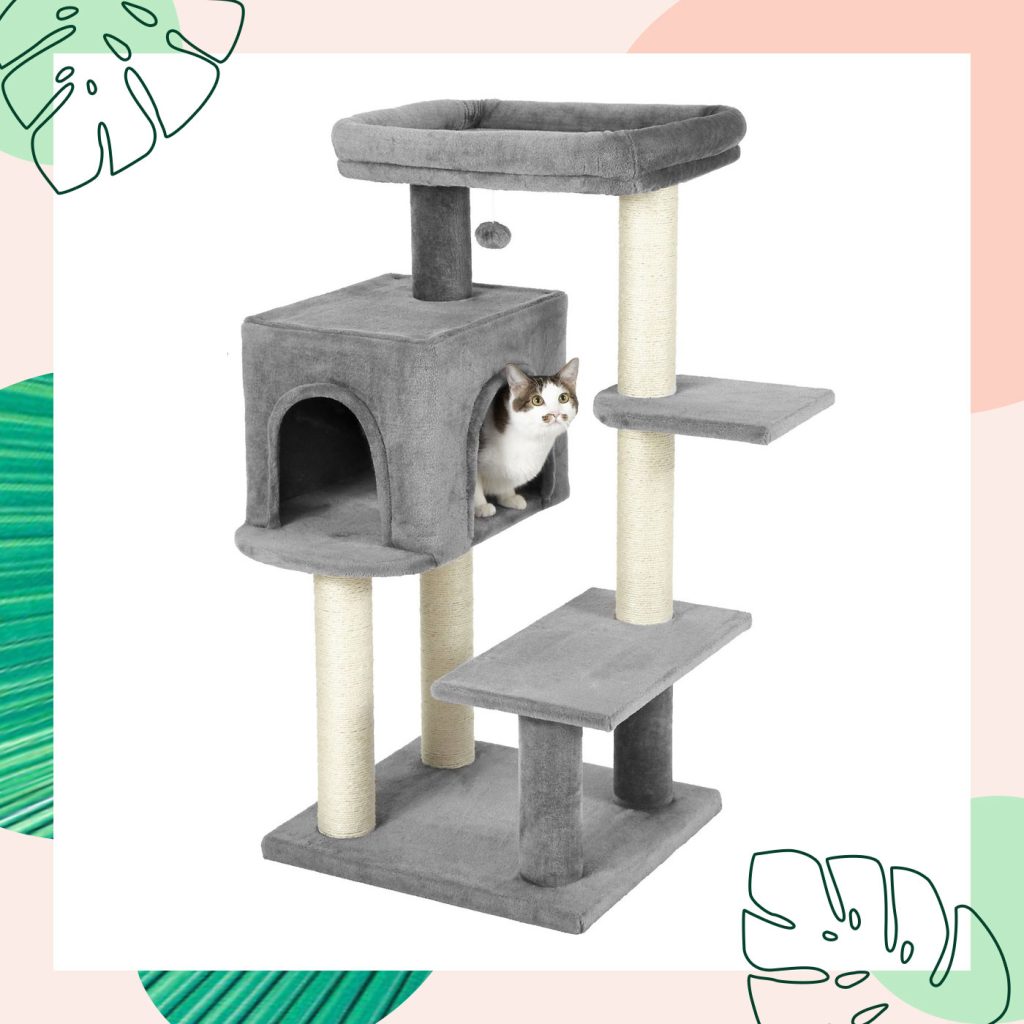
Training Your Cat to Use a Cat Tree
Introducing the cat tree gradually
Cats are creatures of habit, so introducing the cat tree gradually can help them adjust more easily. Start by placing the cat tree in a room where your cat spends a lot of time and allow them to explore it at their own pace. You can also encourage them by placing treats or toys on different levels of the cat tree. Over time, your cat will become more comfortable and start using the cat tree regularly.
Using positive reinforcement techniques
Positive reinforcement techniques, such as treats, praise, and playtime, can be employed to train your cat to use the cat tree. Whenever your cat climbs or uses the cat tree, reward them with a treat and praise. This positive association will make the cat tree a desirable place to be and increase the likelihood of your cat using it consistently.
Redirecting inappropriate scratching behavior
If your cat has a habit of scratching furniture or other inappropriate surfaces, it is important to redirect their behavior to the scratching posts on the cat tree. When you catch your cat scratching an undesirable surface, gently redirect them to the cat tree’s scratching posts and reward them when they use them. Consistency and patience are key to training your cat to use the cat tree for scratching.
Patience and repetition
Training your cat to use a cat tree may require patience and repetition. Some cats may take longer to warm up to the cat tree or understand its purpose. Be consistent with positive reinforcement techniques and provide ample opportunities for your cat to explore and use the cat tree. With time, your cat will develop a positive association with the cat tree and make it a part of their daily routine.
Reviews and Recommendations
Top-rated cat trees for small spaces
For cat owners living in small apartments or with limited space, there are several top-rated cat trees that offer a compact design without compromising functionality. These cat trees often feature a vertical design with multiple levels, platforms, and scratching posts, while still being space-efficient. Popular options include the Go Pet Club 62-Inch Cat Tree and the New Cat Condos Premier Triple Cat Perch.
Best cat trees for multiple cats
If you have multiple cats, it is important to choose a cat tree that can accommodate all of them comfortably. Look for cat trees with multiple perches, platforms, and hiding spots to accommodate each cat’s individual space preferences. The Armarkat Cat Tree Furniture Condo is a highly recommended cat tree for multiple cats, with its ample levels and spaces to accommodate multiple feline friends.
Budget-friendly options
Cat trees come in a wide range of price points, and there are plenty of budget-friendly options available that still offer quality and functionality. The AmazonBasics Cat Tree with Cave and Scratching Post is a popular choice among budget-conscious cat owners. It provides multiple levels, a cozy hideaway, and a scratching post at an affordable price.
Premium cat trees with luxury features
For those who want to spoil their feline companions with luxury, there are premium cat trees available with luxurious features. These cat trees often include luxurious materials, such as faux fur or high-quality carpeting, as well as additional features like hammocks, tunnels, and built-in feeding stations. The Refined Feline Lotus Cat Tower and the Molly and Friends “Pinnacle” Extra-Large Premium Handmade Cat Tree are two examples of premium cat trees with luxury features.
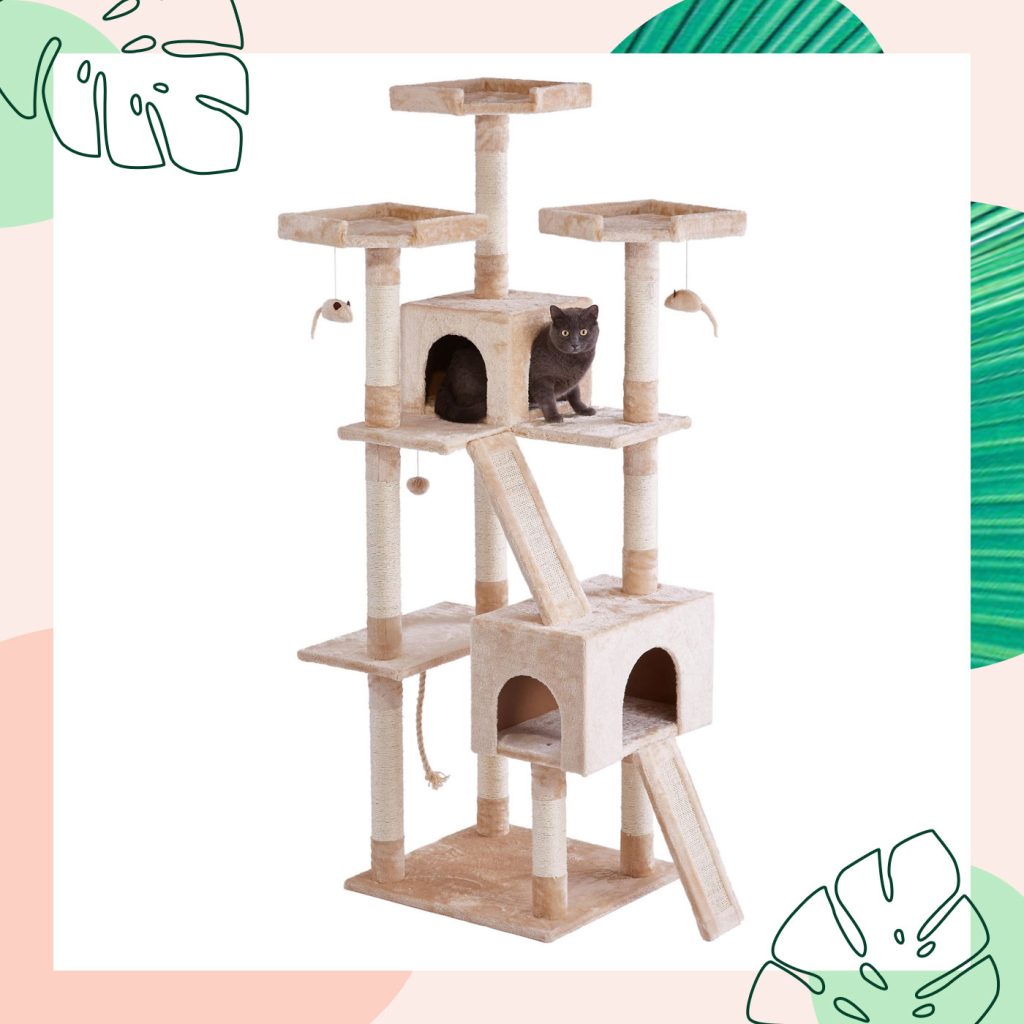
DIY Cat Tree Ideas
Materials and tools needed
If you enjoy DIY projects, building a cat tree from scratch can be a rewarding endeavor. To build a cat tree, you will need the following materials:
- Sturdy wood or PVC pipes for the main structure
- Sisal rope or fabric for scratching posts
- Carpet or upholstery fabric for platforms and perches
- Screws, brackets, and other hardware for assembly
- Tools such as a saw, drill, and screwdriver
Step-by-step instructions
Building a cat tree requires careful planning and construction. Here is a general step-by-step guide to building a basic cat tree:
- Design your cat tree by sketching out the desired levels, platforms, and perches.
- Cut the wood or PVC pipes to the desired lengths for the main structure.
- Attach the pieces together using screws and brackets to create the framework of the cat tree.
- Wrap the sisal rope around the designated areas to create scratching posts.
- Attach carpet or upholstery fabric to the platforms and perches using a staple gun or adhesive.
- Secure the platforms and perches onto the framework of the cat tree.
- Add any additional features, such as hanging toys or hideaway compartments.
- Double-check the stability and integrity of the cat tree before allowing your cat to use it.
Remember to personalize the cat tree to your cat’s preferences, such as incorporating their favorite toys or adding cozy bedding to the platforms.
Safety considerations
When building a DIY cat tree, it is important to prioritize safety. Ensure that all materials used are non-toxic and sturdy enough to support your cat’s weight without the risk of collapse. Check that all screws and brackets are securely fastened and that there are no sharp edges or protruding nails that could harm your cat. Regularly inspect the cat tree for any signs of wear or damage, and make necessary repairs or replacements as needed.
Personalizing the cat tree
One of the advantages of building a DIY cat tree is the ability to personalize it to your cat’s preferences. Consider incorporating your cat’s favorite colors, patterns, or textures into the design. Add features or attachments that your cat enjoys, such as toys, feathers, or even a small basking area near a window. Personalizing the cat tree will make it even more appealing and enjoyable for your furry friend.
Conclusion
Choosing the perfect cat tree for your feline friend is an investment in their physical and mental well-being. Understanding the benefits and features of cat trees allows you to make an informed decision that suits both your cat’s needs and your home environment. Whether you opt for a pre-made cat tree or decide to embark on a DIY project, providing your cat with a designated space for climbing, scratching, and resting enhances their quality of life and strengthens the bond between you and your beloved pet. Remember to prioritize safety, maintenance, and personalization to create a durable and enjoyable cat tree that will bring joy to your cat for years to come.
